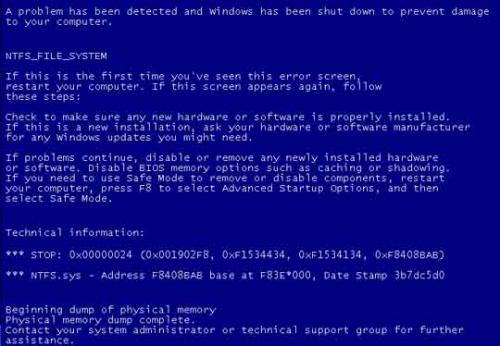-
-
products
-
resources
-
support
-
company
-
A Guide to the “NTFS File System” Blue Screen of Death Error
By Steve Horton June 26, 2012Blue Screen of Death, bsod, NTFS_FILE_SYSTEM3 CommentsThis article is the second in a series on Blue Screen of Death errors. A Blue Screen of Death (BSoD) is the error screen you see when Windows has a major issue. It halts the PC and displays some very important information.
Depending on the error message you get, the steps you need to take are different.
Error Name:
NTFS_FILE_SYSTEM
The NTFS_FILE_SYSTEM error means your hard drive is corrupted. Hopefully, you’ve been running regular backups of your hard drive; if not, it may be difficult or impossible to do so now. The best thing to do is to run an error scan of your hard drive. Since the drive’s not working, you’ll need to A. boot from another drive; B. boot from a Windows Recovery CD; or C. boot from your Windows disc.
To boot from another drive:
- Reboot and enter the BIOS by pressing F2 or DEL before the Windows logo appears (and before your BSoD hits again)
- Change the boot order to the D: drive (or whatever letter your backup drive is using). Make sure it has Windows on it
- Save and quit.
- When you get into Windows on your other drive, click Start
- Type CMD and press Enter
- Type chkdsk /r c: (replace c: with the drive letter of the hard drive that’s acting up)
Note: Windows may be calling the current drive C: and the old drive D: after booting from the backup drive. Make sure you choose the correct one to scan
To create and boot from a Windows recovery CD:
- Read this guide on creating and booting from a Windows Recovery CD
- Choose your language, click Next, then click Repair Your Computer
- Choose your operating system (there will likely be only one listed), then click Next again
- Select Use Recovery Tools That Can Help Fix Problems Starting Windows and click Next
- Choose the last option to open a Command Prompt
- Type chkdsk /r c: (replace c: with the drive letter of the hard drive that’s acting up)
To boot from your Windows disc:
- Reboot and enter the BIOS by pressing F2 or DEL before the Windows logo appears (and before your BSoD hits again)
- Change the boot order to boot from CD/DVD first
- Put your Windows disc in the drive
- Save and quit and restart the PC
- Choose your language, click Next, then click Repair Your Computer
- Choose your operating system (there will likely be only one listed), then click Next again
- Select Use Recovery Tools That Can Help Fix Problems Starting Windows and click Next
- Choose the last option to open a Command Prompt
- Type chkdsk /r c: (replace c: with the drive letter of the hard drive that’s acting up)
After Windows has attempted to repair the drive, go back into BIOS and choose to boot from your primary drive again. With luck, you’ll be able to get into Windows. Keep in mind that an error -prone drive could crash again at any time, so your best bet is to back up all your files (or create a backup image of your entire drive), buy a new hard drive, and restore the backup to it.
Good luck!
Was this post helpful?YesNoFree Driver Updates
Update your drivers in less than 2 minutes to enjoy better PC performance - Free.
Free Driver Updates
Update your drivers in less than 2 minutes to enjoy better
PC performance - Free.
Didn't find your answer?Ask a question to our community of experts from around the world and receive an answer in no time at all.most relevant recent articles Pin It on Pinterest

